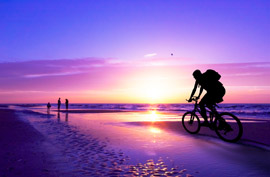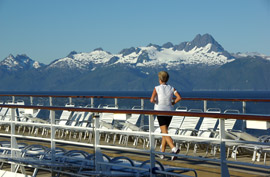 Without access to your local supermarket or your favorite Pilates DVD, on your next trip you may find yourself subsisting on fattening restaurant meals and abandoning your usual exercise routine to sit for long hours on planes or buses. Vegetarian, organic, low carb, low cal, low fat -- no matter which diet you're on, there's a good chance that it went down the tubes on your last vacation.
Without access to your local supermarket or your favorite Pilates DVD, on your next trip you may find yourself subsisting on fattening restaurant meals and abandoning your usual exercise routine to sit for long hours on planes or buses. Vegetarian, organic, low carb, low cal, low fat -- no matter which diet you're on, there's a good chance that it went down the tubes on your last vacation.
But believe it or not, it is possible to eat well on a cross-country road trip, to stay active without access to a gym and even to go on a cruise without gaining 5 or 10 pounds. You can eat healthy and stay active no matter what kind of trip you're taking.
On the PlaneThere's no more captive audience than a plane full of air travelers, particularly those on long international flights. But just because you're stuck on a plane doesn't mean you're stuck eating the congealed meat and starchy sides the airlines call food. (That's if your airline serves meals at all.)
Your first line of defense against unhealthy airline menus is to bring what food you can from home. Airport security rules prohibit passengers from taking liquids and gels in excess of 3.4 ounces through airport security checkpoints, but solid snacks like bananas, apples, trail mix, nuts, carrots, celery sticks and energy bars should pass muster. Pack a few of these in your carry-on and skip the airline's salty snacks.
Once you've passed through security, anything you buy at the airport may be brought onto your flight, so this is your chance to stock up on bottled water and buy a salad or sandwich to eat on the plane. Many airports have begun adding more healthy dining options to their standard array of fast food; look for dishes with lots of vegetables and fiber, and skip the fried stuff.
In flight, avoid alcohol and soft drinks -- both can dehydrate you. Water is always your best bet for staying hydrated and sticking to your diet.
 Healthiest Airport Food (and Airport Food to Avoid)
Healthiest Airport Food (and Airport Food to Avoid)
Long hours of sitting in the car and eating fast food at every rest stop can derail a diet faster than you can say "road trip." How can you break the cycle? First, take McDonald's off the menu. Before you set forth on your journey, fill a cooler with healthy snacks like fruit, raw veggies and sandwiches from home, and then restock your stash along the way with offerings from local grocery stores. Don't forget the bottled water! (Save money and the environment by purchasing gallon jugs of water to use to refill your bottles.)
 Bypass rest stops and seek out independent cafes and restaurants -- not only will you eat better, but you'll also meet locals and get a better flavor of the town you're in. For help finding healthy local eateries, try the VegOut app, which offers listings of nearby vegan, vegetarian and vegetarian-friendly restaurants. GoodFoodNearYou is another useful app that pinpoints the healthiest menu options at restaurants in your area, including fast food chains.
Bypass rest stops and seek out independent cafes and restaurants -- not only will you eat better, but you'll also meet locals and get a better flavor of the town you're in. For help finding healthy local eateries, try the VegOut app, which offers listings of nearby vegan, vegetarian and vegetarian-friendly restaurants. GoodFoodNearYou is another useful app that pinpoints the healthiest menu options at restaurants in your area, including fast food chains.
On particularly long car trips, be sure to stop at least once a day for an exercise break. Check your road map or GPS for nearby national, state or local parks where you can go for a hike, or spend some time exploring a new town or city by foot.
 The Eight Best U.S. Road Trips
The Eight Best U.S. Road Trips
When choosing a hotel, look for one that offers a fitness center or pool -- and then use it once you get there! Most major booking sites allow you to customize your search to show only hotels that offer certain fitness amenities.
If your hotel doesn't have a gym, why not bring your own? We don't advise trying to squeeze a set of dumbbells into your suitcase, but it's easy enough to pack a resistance band or to download an exercise program onto your MP3 player so that you can work out in your room. (iTRAIN is one of several companies providing downloadable workouts.) As a lower-tech option, you can always jog around the local neighborhood, make your own exercise routine of jumping jacks and squats, or do some early-morning stretches or stomach crunches before heading out for the day.
You may also want to consider booking a hotel room with a kitchenette or even renting a house or apartment so that you can do your own cooking. This will save you money on food and give you more control over your diet.
At Sea Cruise ships have a well-deserved reputation as bastions of gluttony, with food, food and more food available literally 24 hours a day on many ships. Luckily, amid all the pizza, creamy pastas and self-serve ice cream, most cruise lines also offer lighter and healthier options with reduced fat, sodium and/or carbs. Royal Caribbean, Carnival, Holland America and many other lines have eliminated trans fats completely from their dining rooms, and on most ships you'll find vegetarian and other healthier options clearly marked on the menus.
Cruise ships have a well-deserved reputation as bastions of gluttony, with food, food and more food available literally 24 hours a day on many ships. Luckily, amid all the pizza, creamy pastas and self-serve ice cream, most cruise lines also offer lighter and healthier options with reduced fat, sodium and/or carbs. Royal Caribbean, Carnival, Holland America and many other lines have eliminated trans fats completely from their dining rooms, and on most ships you'll find vegetarian and other healthier options clearly marked on the menus.
Along with overeating, cruisers have also traditionally faced the temptation to laze around by the pool instead of staying active -- but on today's ships, there's no reason not to exercise if you have the motivation. Nearly all modern vessels have a gym and jogging track at the bare minimum, and most also offer a number of fitness classes (yoga, aerobics, etc.) that passengers can take thoughout their cruise.
Newer ships, particularly those in the Royal Caribbean fleet, have everything from ice skating rinks and rock-climbing walls to bowling alleys and boxing rings. But here's perhaps the simplest way to get in a little extra exercise: don't take the elevator. Most modern-day mega-ships have so many decks that jogging up or down the stairs every time you need to get somewhere will easily help you burn a few extra calories.
For more information on healthy dining and active onboard options, see 17 Ways a Cruise Can Keep You Healthy.
Off the ship, choose active shore excursions -- like hiking or kayaking around a Caribbean island rather than touring it by motorcoach, or snorkeling instead of lying on the beach all day. Do enough physical activity during the day, and maybe you can even treat yourself to an order of late-night room service!
 Nine Best Destinations to See from the Water
Nine Best Destinations to See from the Water
The possibilities for active getaways around the world are almost limitless -- think skiing in the Alps, horseback riding in Montana or canoeing down the Amazon River. But even if you're not up for that much outdoor adventure, there's a lot more you can do than just sit on a bus and passively take in the scenery.
For example, you can see Europe by bicycle with Bike Tours Direct, a clearinghouse for guided and self-guided tours through dozens of countries, including Italy, France, Austria and Portugal. You'll cycle along scenic river banks, past vineyards and through medieval towns, combining all-day exercise with a more intimate look at the European countryside than you could ever get from the seat of a bus. For more ideas, see Bike Tours and Trips.
 A similar opportunity is available for joggers in cities across the U.S. with City Running Tours. Personalized routes take runners through the West Village, along the National Mall or up and down the hills of San Francisco, to name just a few.
A similar opportunity is available for joggers in cities across the U.S. with City Running Tours. Personalized routes take runners through the West Village, along the National Mall or up and down the hills of San Francisco, to name just a few.
Jogging and biking aside, you can't go wrong with good old-fashioned walking. There's no better way to experience a city than on foot, so take time to walk between major attractions rather than jumping on a bus or a subway. You'll experience the flavor of different neighborhoods and be able to duck into any cafe or shop that strikes your fancy along the way.
For info on vacations dedicated to walking or hiking, see Walking Tours and Trips.
A Note on Eating InternationallyWe've mentioned salads as a great healthy option when you're on the road, but if you're in a developing country where your risk of food- or water-borne illness is high, you'll want to pass on raw fruits and vegetables. Instead, try to find dishes that feature cooked vegetables, and make sure they're served piping hot. Similarly, while water remains your healthiest beverage option, you'll want to check that your drinking supply is safe, particularly if you're traveling in a developing country.
For more information, see Food Safety and Drinking Water Safety.